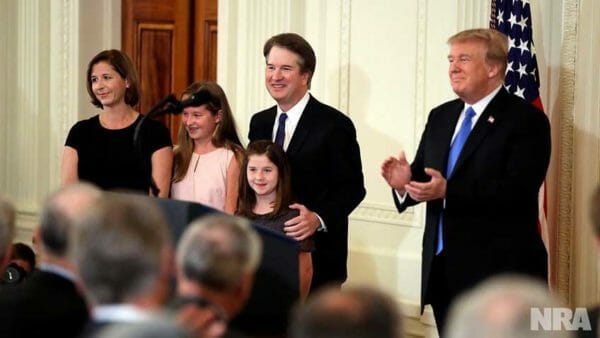
U.S.A. –-(AmmoLand.com)- “Injustice anywhere is a threat to justice everywhere. We are caught in an inescapable network of mutuality, tied in a single garment of destiny. Whatever affects one directly, affects all indirectly.” ~ Martin Luther King Jr., Letter from the Birmingham Jail; often miscited in abbreviated form as: “Justice delayed is justice denied.” Various renditions of the quotation have come down through the ages, recited by many learned and famous men. The origin of the quotation likely came from William Penn (1644 to 1718), who asserted, “To delay Justice is injustice.”
WHAT IS JUSTICE?
Black’s Law Dictionary says this about the concept, ‘justice:’ “In jurisprudence. The constant and perpetual disposition to render every man his due. . . . In the most extensive sense of the word it differs little from ‘virtue;’ for it includes within itself the whole circle of virtues. . . . But ‘justice,’ being in itself a part of ‘virtue,’ is continued to things simply good or evil, and consists in a man’s taking such a proportion of them as he ought. Bouvier. Commutative justice is that which should govern contracts. It consists in rendering to every man the exact measure of his dues, without regard to his personal worth or merits, i. e., placing all men on an equality. . . .”
WAS JUSTICE METED OUT TO PETITIONERS IN THE NYC GUN TRANSPORT CASE?
Some good Americans think the principal Petitioner, the New York State Rifle & Pistol Association (NYSRPA) prevailed in New York State Rifle & Pistol Association, Inc., vs. Petitioners V. City Of New York, 590 U.S ____ (2020), simply because New York City—evidently fearing loss if the case were decided on the merits—capitulated, redrafting New York City regulations and New York State Statute, permitting New York City holders of restricted handgun premise licenses to lawfully take their firearms out of the City. The U.S. Supreme Court agreed to hear the mootness issue and found for the City against NYSRPA.
Nonetheless, can this case legitimately be considered a win for NYSRPA? Holders of such New York City restricted handgun licenses are not permitted to use the firearm for self-defense outside of the residence or business to which the license confers or deigns a “right” (more a “privilege”) of use for self-defense? And questions remain as to limitations on the import of travel to and from the residence or business establishment—questions that could only have been resolved were the case to be decided on the merits.
Some Second Amendment scholars with whom AQ has since spoken believed the New York City case was not a good Second Amendment case to be decided by the Court, not least of all because it allowed the City to exploit the problems, predictably. These scholars believe that Kavanaugh, having urged, in his concurring opinion, for another Second Amendment case—among those presently pending on a writ of certiorari—to be taken up by the Court means that the Court will, shortly, take up another Second Amendment case. The idea, then, is that the NYC case was important for that reason alone.
Be that as it may, it still does not explain why, if Justice Kavanaugh agreed with Chief Justice Roberts and the liberal wing of the U.S. Supreme Court in ruling in favor of New York City, against the New York State Rifle & Pistol Association (NYSRPA) in New York State Rifle & Pistol Association, Inc., vs. Petitioners V. City Of New York, 590 U.S ____ (2020), on the mootness issue.
Why didn’t Justice Kavanaugh just add his name to that of the liberal wing of the Court and to that of Chief Justice Roberts, in deciding in favor of the City, and leave it at that?
Did Justice Kavanaugh feel a jurisprudential need to write a concurring opinion, knowing that going along with the liberal wing is not what would be expected of him, given his past deference to the Second Amendment of the Bill of Rights, in his well-reasoned, comprehensive dissent in Heller II?
Did Associate Justice Kavanaugh feel he needed to write a concurring opinion, knowing that siding with Chief Justice Roberts and the liberal wing of the High Court, against the conservative wing, comprising, Justices, Alito, Thomas, and Gorsuch, would lead the American public, to infer, not unreasonably, legal and logical inconsistency and incongruous intellectual dishonesty on Kavanaugh’s part—something impossible for him to hide? Perhaps. But no one really knows because no reporter or commentator has even bothered to hazard a guess as to Justice Kavanaugh’s motives or motivation for drafting a concurring at all.
Does Justice Kavanaugh know for a certainty the High Court will in fact take up for review another and more significant Second Amendment case and did he intend to use a concurring opinion specifically to inform the legal community and the public of that fact?
No commentator, to date, to our knowledge, has explored these questions and that leaves us in a quandary as to Kavanaugh's intentions.
For example, on April 27, 2020, Amy Howe, independent contractor, and reporter, who writes regularly for the SCOTUS blog, simply reiterated the simple fact that:
“Justice Brett Kavanaugh filed a concurring opinion in which he explained that he agreed with the majority that the gun owners’ original claims are moot and that the new claims should be addressed first by the lower courts. But Kavanaugh also indicated that he agreed with Alito’s ‘general analysis of Heller and McDonald v. City of Chicago,’ in which the court made clear that the Second Amendment applies fully to the states, and that he shares Alito’s ‘concern that some federal and state courts may not be properly applying Heller and McDonald.’ Kavanaugh posited that the Supreme Court ‘should address that issue soon, perhaps in one of the several Second Amendment cases with petitions for certiorari now pending before the Court.’”
In her follow-up article, dated April 28, 2020, on SCOTUS blog, Amy Howe, reiterated the fact that:
“The court’s electronic docket reveals that Kavanaugh’s suggestion may come to fruition soon: By the end of the day yesterday, the Supreme Court had distributed for consideration at Friday’s conference 10 cases that had apparently been on hold for the New York case.”
Is this a cause for rejoicing simply because writs of certiorari in several Second Amendment cases have been filed with the Supreme Court and are pending a vote? The idea that the Supreme Court ‘should’ address the issue whether Courts are properly applying Heller and McDonald doesn’t mean that the Supreme Court ‘will’ address that issue.
Possibility is not the same thing as probability, and even less, certainty. And, if the Court does agree to hear another Second Amendment case, when might that be? And, if soon, will the Court actually address the issue whether Appellate Courts had properly applied Heller and McDonald? Lastly, how would such a case be decided? These are not spurious questions. They are serious ones and unsettling ones, worthy of speculation. And the point of this speculation is that the New York City gun transport case was the first case to come down the pike ten years after McDonald, involving a core Second Amendment issue (with the exception of the seeming quasi Second Amendment Voisine case)
Keep in mind, there have been many Second Amendment cases that came before the High Court on writs of certiorari, in the intervening years between the seminal rulings in Heller and McDonald and the negative decision in the New York City gun transport case. Each of those cases “should” have been reviewed but were not reviewed. What happened to those petitions?
The answer is nothing happened.
Those cases the Supreme Court failed to review reflect, to a one, the fact that U.S. Circuit Courts of Appeal, around the Country, blatantly and defiantly ignored case precedent clearly and categorically laid down in Heller and McDonald.
POSTSCRIPT
In future segments, we will begin our comprehensive analysis of what to our mind is Justice Kavanaugh’s bizarre concurring opinion in the New York City gun transport case, and we will address the mootness issue head-on.
We will strive to decipher Kavanaugh’s concurring to ascertain if Kavanaugh’s decision, siding with the Chief Justice Roberts and the liberal wing of the Court, is merely an anomaly or if it portends something ominous: an entire rethinking of Kavanaugh’s philosophy pertaining to the Second Amendment? Our aim, in forthcoming articles, will be to determine whether Americans can trust Brett Kavanaugh to remain true to his Oath to preserve and defend the Constitution of the United States.

About The Arbalest Quarrel:
Arbalest Group created `The Arbalest Quarrel' website for a special purpose. That purpose is to educate the American public about recent Federal and State firearms control legislation. No other website, to our knowledge, provides as deep an analysis or as thorough an analysis. Arbalest Group offers this information free.
For more information, visit: www.arbalestquarrel.com.
The post Justice Kavanaugh: Friend or Foe to the Second Amendment? appeared first on AmmoLand.com.
from https://ift.tt/2TA9S67
via IFTTT

No comments:
Post a Comment